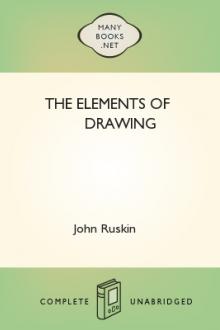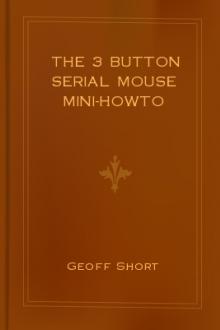The Elements of Drawing by John Ruskin (smart books to read .txt) 📕

xii. One task, however, of some difficulty, the student will find I have not imposed upon him: namely, learning the laws of perspective. It would be worth while to learn them, if he could do so easily; but without a master's help, and in the way perspective is at present explained in treatises, the difficulty is greater than the gain. For perspective is not of the slighte
Read free book «The Elements of Drawing by John Ruskin (smart books to read .txt) 📕» - read online or download for free at americanlibrarybooks.com
- Author: John Ruskin
- Performer: -
Read book online «The Elements of Drawing by John Ruskin (smart books to read .txt) 📕». Author - John Ruskin
201. I will leave our chosen illustrative composition for a moment to take up another, still more expressive of this law. It is one of Turner's most tender studies, a sketch on Calais Sands at sunset; so delicate in the expression of wave and cloud, that it is of no use for me to try to reach it with any kind of outline in a wood-cut; but the rough sketch, Fig. 33, is enough to give an idea of its arrangement. The aim of the painter has been to give the intensest expression of repose, together with the enchanted, lulling, monotonous motion of cloud and wave. All the clouds are moving in innumerable ranks after the sun, meeting towards that point in the horizon where he has set; and the tidal waves gain in winding currents upon the sand, with that stealthy haste in which they cross each other so quietly, at their edges; just folding one over another as they meet, like a little piece of ruffled silk, and leaping up a little as two children kiss and clap their hands, and then going on again, each in its silent hurry, drawing pointed arches on the sand as their thin edges intersect in parting. But all this would not have been enough expressed without the line of the old pier-timbers, black with weeds, strained and bent by the storm waves, and now seeming to stoop in following one another, like dark ghosts escaping slowly from the cruelty of the pursuing sea.
202. I need not, I hope, point out to the reader the illustration of this law of continuance in the subject chosen for our general illustration. It was simply that gradual succession of the retiring arches of the bridge which induced Turner to paint the subject at all; and it was this same principle which led him always to seize on subjects including long bridges wherever he could find them; but especially, observe, unequal bridges, having the highest arch at one side rather than at the center. There is a reason for this, irrespective of general laws of composition, and connected with the nature of rivers, which I may as well stop a minute to tell you about, and let you rest from the study of composition.
203. All rivers, small or large, agree in one character, they like to lean a little on one side: they cannot bear to have their channels deepest in the middle, but will always, if they can, have one bank to sun themselves upon, and another to get cool under; one shingly shore to play over, where they may be shallow, and foolish, and childlike, and another steep shore, under which they can pause, and purify themselves, and get their strength of waves fully together for due occasion. Rivers in this way are just like wise men, who keep one side of their life for play, and another for work; and can be brilliant, and chattering, and transparent, when they are at ease, and yet take deep counsel on the other side when they set themselves to their main purpose. And rivers are just in this divided, also, like wicked and good men: the good rivers have serviceable deep places all along their banks, that ships can sail in; but the wicked rivers go scooping irregularly under their banks until they get full of strangling eddies, which no boat can row over without being twisted against the rocks; and pools like wells, which no one can get out of but the water-kelpie that lives at the bottom; but, wicked or good, the rivers all agree in having two kinds of sides. Now the natural way in which a village stone-mason therefore throws a bridge over a strong stream is, of course, to build a great door to let the cat through, and little doors to let the kittens through; a great arch for the great current, to give it room in flood time, and little arches for the little currents along the shallow shore. This, even without any prudential respect for the floods of the great current, he would do in simple economy of work and stone; for the smaller your arches are, the less material you want on their flanks. Two arches over the same span of river, supposing the butments are at the same depth, are cheaper than one, and that by a great deal; so that, where the current is shallow, the village mason makes his arches many and low: as the water gets deeper, and it becomes troublesome to build his piers up from the bottom, he throws his arches wider; at last he comes to the deep stream, and, as he cannot build at the bottom of that, he throws his largest arch over it with a leap, and with another little one or so gains the opposite shore. Of course as arches are wider they must be higher, or they will not stand; so the roadway must rise as the arches widen. And thus we have the general type of bridge, with its highest and widest arch towards one side, and a train of minor arches running over the flat shore on the other: usually a steep bank at the river-side next the large arch; always, of course, a flat shore on the side of the small ones: and the bend of the river assuredly concave towards this flat, cutting round, with a sweep into the steep bank; or, if there is no steep bank, still assuredly cutting into the shore at the steep end of the bridge.
Now this kind of bridge, sympathizing, as it does, with the spirit of the river, and marking the nature of the thing it has to deal with and conquer, is the ideal of a bridge; and all endeavors to do the thing in a grand engineer's manner, with a level roadway and equal arches, are barbarous; not only because all monotonous forms are ugly in themselves, but because the mind perceives at once that there has been cost uselessly thrown away for the sake of formality.[57]
Fig. 34. Fig. 34.204. Well, to return to our continuity. We see that the Turnerian bridge in Fig. 32 is of the absolutely perfect type, and is still farther interesting by having its main arch crowned by a watch-tower. But as I want you to note especially what perhaps was not the case in the real bridge, but is entirely Turner's doing, you will find that though the arches diminish gradually, not one is regularly diminished—they are all of different shapes and sizes: you cannot see this clearly in Fig. 32, but in the larger diagram, Fig. 34, over leaf, you will with ease. This is indeed also part of the ideal of a bridge, because the lateral currents near the shore are of course irregular in size, and a simple builder would naturally vary his arches accordingly; and also, if the bottom was rocky, build his piers where the rocks came. But it is not as a part of bridge ideal, but as a necessity of all noble composition, that this irregularity is introduced by Turner. It at once raises the object thus treated from the lower or vulgar unity of rigid law to the greater unity of clouds, and waves, and trees, and human souls, each different, each obedient, and each in harmonious service.
4. THE LAW OF CURVATURE.
205. There is, however, another point to be noticed in this bridge of Turner's. Not only does it slope away unequally at its sides, but it slopes in a gradual though very subtle curve. And if you substitute a straight line for this curve (drawing one with a rule from the base of the tower on each side to the ends of the bridge, in Fig. 34, and effacing the curve), you will instantly see that the design has suffered grievously. You may ascertain, by experiment, that all beautiful objects whatsoever are thus terminated by delicately curved lines, except where the straight line is indispensable to their use or stability; and that when a complete system of straight lines, throughout the form, is necessary to that stability, as in crystals, the beauty, if any exists, is in color and transparency, not in form. Cut out the shape of any crystal you like, in white wax or wood, and put it beside a white lily, and you will feel the force of the curvature in its purity, irrespective of added color, or other interfering elements of beauty.
Fig. 35. Fig. 35.206. Well, as curves are more beautiful than straight lines, it is necessary to a good composition that its continuities of object, mass, or color should be, if possible, in curves, rather than straight lines or angular ones. Perhaps one of the simplest and prettiest examples of a graceful continuity of this kind is in the line traced at any moment by the corks of a net as it is being drawn: nearly every person is more or less attracted by the beauty of the dotted line. Now, it is almost always possible, not only to secure such a continuity in the arrangement or boundaries of objects which, like these bridge arches or the corks of the net, are actually connected with each other, but—and this is a still more noble and interesting kind of continuity—among features which appear at first entirely separate. Thus the towers of Ehrenbreitstein, on the left, in Fig. 32, appear at first independent of each other; but when I give their profile, on a larger scale, Fig. 35, the reader may easily perceive that there is a subtle cadence and harmony among them. The reason of this is, that they are all bounded by one grand curve, traced by the dotted line; out of the seven towers, four precisely touch this curve, the others only falling hack from it here and there to keep the eye from discovering it too easily.
Fig. 36. Fig. 36.207. And it is not only always possible to obtain continuities of this kind: it is, in drawing large forests or mountain forms, essential to truth. The towers of Ehrenbreitstein might or might not in reality fall into such a curve, but assuredly the basalt rock on which they stand did; for all mountain forms not cloven into absolute precipice, nor covered by straight slopes of shales, are more or less governed by these great curves, it being one of the aims of Nature in all her work to produce them. The reader must already know this, if he has





Comments (0)